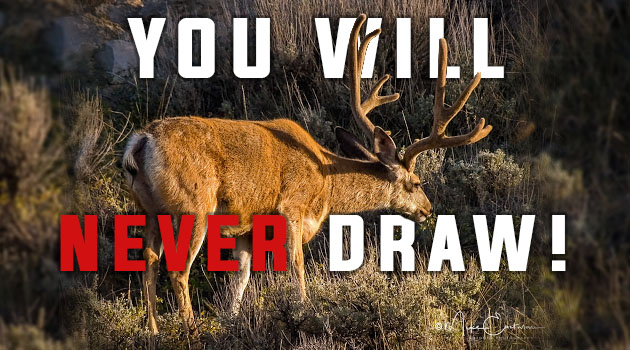
Statistically, the most coveted deer permit in Montana is just outside Darby in the southernmost portion of the Bitterroot Valley. This has been considered the holy grail of mule deer permits in the Big Sky State for the past couple decades. The permit is known as 270-50. Historically, a hunter with some gumption has a legitimate chance at a 180” buck here and many bigger have been harvested. I have applied for this tag almost every year for the 25 years I was a resident and a couple years as a nonresident. This is an extremely hard tag to draw with “sheep like” draw odds. So put on your sweatband and grab your stress ball, we’re going to take a look at the hard numbers. As a reminder, Montana has a squared bonus point system. If you have two points, that gives you four chances in the drawing. If you have max points (16), you have 256 chances in the drawing.
In 2019 there were 7,654 resident applicants for about 35 tags. Because nonresidents are in the same pool, there are 8,543 applicants in the total pool. Due to the vast quantity of applicants for this unit, the point system does very little for you in return. For example, in 2019 there were over 1400 applicants with zero points, and one person drew. There were 96 people with max points and four applicants drew. Applicants with 10 and 12 points also drew four tags respectively. However, by looking at all point levels from 1-16, multiple applicants drew permits in just about every point level from 0-16. These statistics tell us that the bonus point system does not weigh enough in this squared bonus point system to select applicants in the higher point tiers. The moral of the story is, the more applicants the more “washed out” the drawing is, and the less work your expensively purchased points do for you. Resident applicants for this permit are increasing 300-1000 per year proving that the popularity hasn’t waned.
For nonresidents the statistics are even worse. Remember nonresidents are allocated up to 10% of the tags in an area. However, there are no guarantees a nonresident will even get a tag. There are 45 tags total for 270-50. If 10% are allocated to the nonresident draw, that means four tags maximum (rounded down) go to nonresidents. In 2017, three tags went to nonresidents. Zero in 2018 and two nonresidents drew in 2019. This is with roughly 1000 nonresident applicants every year. If you are a regular nonresident this means you are in the pool of 8,543 applicants for four tags. If you have zero points you have a .004% chance of drawing a tag. If you have max points (16) you have a 2% chance at drawing. Yikes! 16 years worth of buying points all for 1.5% better odds than someone with zero points. WTF!!
So you’re probably wondering, how is it possible that zero nonresidents drew this tag in 2018? The answer is landowners. 15% of the 45 permits are guaranteed to resident and nonresident landowners alike. So that is 7 permits skimmed off the top immediately for residents. Then you have the nonresident landowners who get thrown into the nonresident pool but get guaranteed preference of at least 15% of the tags over the rest of the nonresidents. So in 2018, all four of the nonresident tags went to landowners. And every other year at least one or two of the four tags go to landowners. As you can imagine 270-50 has the highest number of landowner applicants for any deer permit and by far the highest for nonresidents. And it has been increasing every year. In 2017, there were five nonresident landowners in area 270 and in 2019 there were eight! This is quite the impressive increase as to qualify to apply for a landowner tag, you have to own or be in contract to own at least 160 acres in that unit. The big takeaway here is, as nonresident landowners suck out more and more of the nonresident pool, expect less and less tags being drawn by general nonresidents.
Holy smokes! I know that is a lot of doom and gloom for area 270 especially if you are a nonresident. I think we also found that the squared bonus point system is not that effective because there are just too many applicants nowadays. But if you’re hell-bent on hunting deer in area 270, you better buy at least 160 acres because that is your best chance at a permit in area 270 in the near future.










